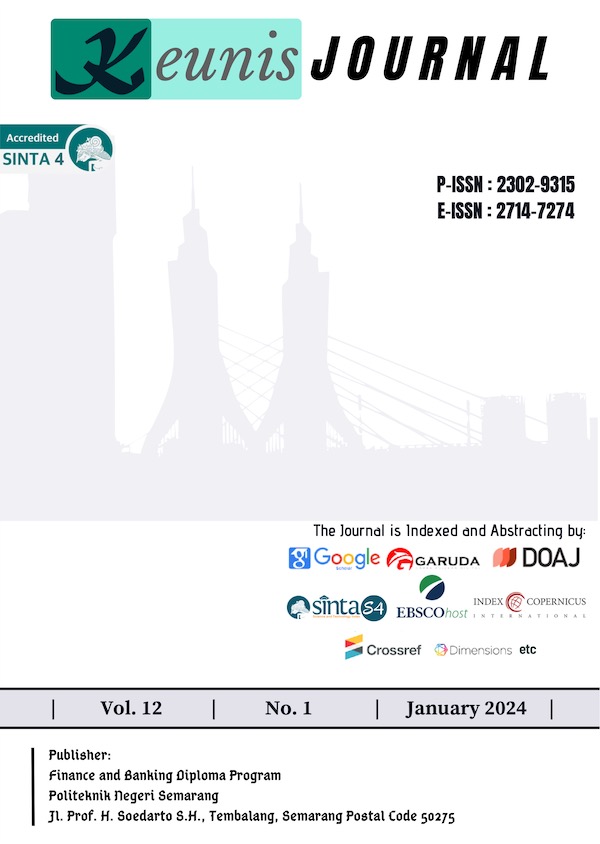MODIFICATION OF TAM MODEL TO ANALYZE CONSUMER BEHAVIOR IN USING QRIS
DOI:
https://doi.org/10.32497/keunis.v12i1.5072Keywords:
TAM, Intention, Decision, QRIS, PLS-SEMAbstract
Digital technology has rapidly developed in recent years, affecting the culture and patterns of transactions. One of the innovations in digital payments is the emergence of the Quick Response Indonesian Standard (QRIS). However, massive QRIS education at all levels of society is not in line with the community's response, which still maintains traditional payment patterns, especially in the Soloraya area. This study aimed to analyze the factors influencing the adoption of QRIS (technology use). This approach was carried out using technology acceptance model modification theory. A sample of 100 people was obtained using a simple random sampling method in communities located in the former Surakarta (Soloraya) residency, namely Sragen, Sukoharjo, Karanganyar, Wonogiri, Klaten, Boyolali and Surakarta City Regencies. Data analysis techniques with partial least squares structural equation Modelling (PLS-SEM). The results show that all variables in the TAM modification construct consisting of perceived usefulness, perceived ease of use, perceived risk and perceived security influence the decision to use QRIS with intention as a mediating variable.References
Antara, & Pratiwi, F. (2022). Jumlah Merchant QRIS Soloraya Meningkat. Republika.Co.Id.
Ashsifa, I. (2020). Pengaruh Technology Acceptance Model (TAM) terhadap Kepuasan Pelanggan dan Niat Penggunaan Mobile Banking Secara Berkelanjutan (Privasi dan Personalisasi sebagai Variabel Moderasi). 3(1), 25”“29.
Astuti, R. D., Wahyuni, S., Rusmini, Supaya, S., & Purnamasari, E. (2020). Pengaruh Nilai manfaat, Milai Kemudahan, dan Risiko terhadap Perilaku Menggunakan Uang Elektronik (E-Money) (Studi Kasus Civitas Akademika Jurusan Administrasi Bisnis (POLINES).
Angewandte Chemie International Edition, 6(11), 951”“952., 465, 106”“111.
Bank Indonesia. (2020). QR Code Indonesian Standart (QRIS). BI.Go.Id.
Bhatnagar, A., Misra, S., & Rao, R. (2000). On Risk, Convenience, and Internet Shopping Behavior. Commun. ACM, 43, 98”“105. https://doi.org/10.1145/353360.353371
Davis, F. (1986). A Technology Acceptance Model For Empirically Testing New End-User Information Systems Theory And Results.
Davis, F. (1989a). Perceived usefulness, perceived ease of use, and user acceptance of information technology. MIS Quarterly: Management Information Systems, 13(3), 319”“339. https://doi.org/10.2307/249008
Davis, F. (1989b). Perceived Usefulness, Perceived Ease of Use and User Acceptance of Information Technology. 13(3), 319”“340. https://doi.org/10.2307/249008
Davis, F. D., Bagozzi, R. P., & Warshaw, P. R. (1989). User Acceptance of Computer Technology: A Comparison of Two Theoretical Models. Management Science, 35(8), 982”“1003. https://doi.org/10.1287/mnsc.35.8.982
Dyki Bungang, R. (2010). The Effect of Perceived Risk and Trust Toward. 1”“20.
Febrianti, D., Hidayah, S. A. L., Abdullah, A., & Lawita, N. F. (2021). Penerapan Basis Data pada Perusahaan Perbankan (Studi Kasus Penerapan Mobile Banking pada Bank Syariah Indonesia). Jurnal Pendidikan Tambusai, 5(2), 3686”“3693.
Ghozali. (2016). Aplikasi Analisis Multivariate dengan IBM Program SPSS. Badan Penerbit UNDIP.
Ghozali, I. (2013). Aplikasi Analisis Multivariate Dengan Program IBM SPSS 21 (7th ed.). Badan Penerbit Universitas Diponegoro.
Ghozali, I., & Latan, H. (2015). Partial Least Squares Konsep, Teknik dan Aplikasi Menggunakan Program SmartPLS 3.0 (Untuk penelitian Empiris) (2nd ed.). Badan penerbit Undip.
Gozali, I., & Latan, H. (2015). Patrial Least Squeres Konsep, Teknik, dan Aplikasi Menggunakan Program SmartPLS3.0. In Semarang: UNDIP. https://doi.org/10.9744/jmk.21.1.1-8
Hidayat, A. A. N. (2021). Bank Indonesia Catat Jumlah Pengguna QRIS Hingga 9 Juta. Tempo.Co.
Hong, W., & Thong, J. Y. L. (2013). Internet Privacy Concerns: An Integrated Conceptualization and Four Empirical Studies. MIS Q., 37, 275”“298.
Huddin, M. N., & Masitoh, M. R. (2021). Persepsi Kegunaan dan kemudahan menggunakan terhadap Niat Menggunakan Mobile Payment dimasa Pandemi Covid-19. Jurnal Al-Qardh, 6(1), 1”“16. https://doi.org/10.23971/jaq.v6i1.2699
Kurniawan, I., & Sukarno, H. (2021). The Shifting Of Qr Code-Based Payment Method To Improve The Competitive Advantage ( Ca ) At Bank Jatim Through Tam Model Approach. 23(3), 22”“27. https://doi.org/10.9790/487X-2303072227
Latan, H., & Noonan, R. (2017). Partial Least Squares Path Modeling: Basic Concepts, Methodological Issues and Applications. In Partial Least Squares Path Modeling: Basic Concepts, Methodological Issues and Applications. https://doi.org/10.1007/978-3-319-64069-3
Lee, H.-J., & Huddleston, P. (2010). An investigation of the relationships among domain-specific innovativeness, overall perceived risk and online purchase behaviour. International Journal of Electronic Marketing and Retailing, 3. https://doi.org/10.1504/IJEMR.2010.030504
Maulana, R., & Mailany, M. (2018). Pengaruh Penggunaan Mobile Banking terhadap Minat Nasabah dalam Bertransaksi Menggunakan TECHNOLOGY Acceptance Model. 2, 146”“155.
Mulyani, D. T., Bukhori, S., & Prasetyo, B. (2019). Penerimaan Layanan Qr Code Sister for Lecturer ( Sfl ) Menggunakan Tec ... Informatics Journal, 1”“6.
Musyaffi, A. M., & Kayati, K. (2020). Dampak Kemudahan dan Risiko Sistem Pembayaran QR Code: Technology Acceptance Model (TAM) Extension. Jurnal Inspirasi Bisnis Dan Manajemen, 3(2), 161. https://doi.org/10.33603/jibm.v3i2.2635
Ningsih, H. A., Sasmita, E. M., & Sari, B. (2021). Pengaruh Persepsi Manfaat, Persepsi Kemudahan Penggunaan, dan Persepsi Risiko Terhadap Keputusan Menggunakan Uang Elektronik ( QRIS ) Pada Mahasiswa. Jurnal IKRA-ITH Ekonomika, 4(1), 1”“9.
Permadi, Y. A., & Wilandari, A. (2021). Preferences of Using Quick Response Code Indonesian Standard ( QRIS ) Among Students as a Means of Digital Payment. Journal of Enterprise and Development, 03(01).
Rahayu, F. S., Budiyanto, D., & Palyama, D. (2017). Analisis Penerimaan E-Learning Menggunakan Technology Acceptance Model (Tam) (Studi Kasus: Universitas Atma Jaya Yogyakarta). Jurnal Terapan Teknologi Informasi, 1(2), 87”“98.
https://doi.org/10.21460/jutei.2017.12.20
Raman, A., & Annamalai, V. (2011). Web Services and e-Shopping Decisions: A Study on Malaysian e-Consumer.
Rastini, N. M., & Respati, N. N. R. (2021). Public Attitudes and Interests in Using Online Transactions (TAM Application And TRA Model). Jurnal Minds: Manajemen Ide Dan Inspirasi, 8(1), 175”“190. https://doi.org/10.24252/minds.v8i1.21348
Saputri, O. B. (2020). Preferensi Konsumen Dalam Menggunakan Quick Response Code Indonesia Standard (QRIS) Sebagai Alat Pembayaran Digital. Journals of Economics and Business Mulawarman, 17(2), 1”“11.
Schiffman, L. G., Kanuk, L. L., & Hansen, H. (2012). Consumer Behaviour: A European Outlook. In Pearson Education. https://doi.org/10.1007/s11096-005-3797-z
Sharma, S. K., Govindaluri, S. M., Al-Muharrami, S., & Tarhini, A. (2017). A multi-analytical model for mobile banking adoption: a developing country perspective. Review of International Business and Strategy, 27(1), 133”“148. https://doi.org/10.1108/RIBS-11-2016-0074
Sugiyono. (2017a). Metode Penelitian Bisnis: Pendekatan Kuantitatif, Kualitatif, Kombinasi, R&D (S. Y. Suryandari (ed.); 3rd ed.). CV Alfabeta.
Sugiyono. (2017b). Metode Penelitian Bisnis (3rd ed.). Alfabeta.
Sutanto, J., Palme, E., Tan, C.-H., & Phang, C. W. (2013). Addressing the Personalization-Privacy Paradox: An Empirical Assessment from a Field Experiment on Smartphone Users. MIS Q., 37, 1141”“1164.
Trisnaningtyas, F. (2021). Dorong Digitalisasi Ekonomi BI solo Gencar Sosialisasi QRIS. Solopos.Com.
Wahyudi, B., & Yanthi, M. D. (2021). Penerimaan Teori Tam Terhadap Penggunaan Mobile Payment Dengan Kompatibilitas Sebagai Variabel Eksternal. Akuntabilitas, 15(1), 55”“72. https://doi.org/10.29259/ja.v15i1.11850
Wandira, R., Fauzi, A., Azim, F., & Annas, F. (2022). Customer Acceptance Analysis Of Indonesia Mobile Banking Using Technology Acceptance ( TAM ). International Journal of Progressive Sciences and Technologies (Ijpsat), 30, 546”“556. https://doi.org/10.52155
Wardani, D. (2021). Faktor-Faktor Pengaruh Penggunaan Mobile Banking (Studi Kasus Pada Nasabah Bank Pemerintah). Jurnal Sistem Informasi Bisnis, 2(1), 15”“32.
Zhou, L., Dai, L., & Zhang, D. (2007). Online shopping acceptance model - A critical survey of consumer factors in online shopping. Journal of Electronic Commerce Research, 8.
Downloads
Published
How to Cite
Issue
Section
License
KEUNIS is licensed under a Creative Commons Attribution-ShareAlike 4.0 International License.
Authors who publish with this journal agree to the following terms:
- Authors retain copyright and grant the journal right of first publication with the work simultaneously licensed under a Creative Commons Attribution-ShareAlike 4.0 International License that allows others to share the work with an acknowledgement of the work's authorship and initial publication in this journal.
- Authors are able to enter into separate, additional contractual arrangements for the non-exclusive distribution of the journal's published version of the work (e.g., post it to an institutional repository or publish it in a book), with an acknowledgement of its initial publication in this journal.
- Authors are permitted and encouraged to post their work online (e.g., in institutional repositories or on their website) prior to and during the submission process, as it can lead to productive exchanges, as well as earlier and greater citation of published work (See The Effect of Open Access).






